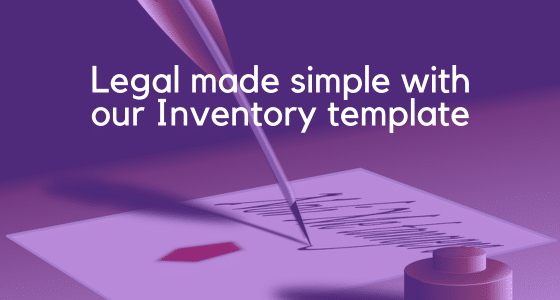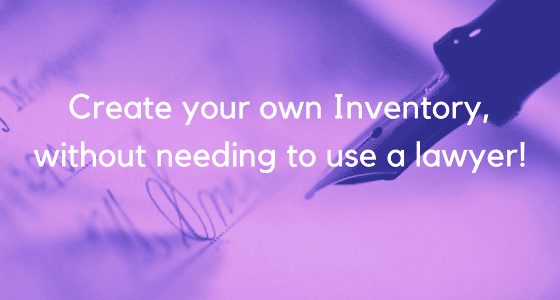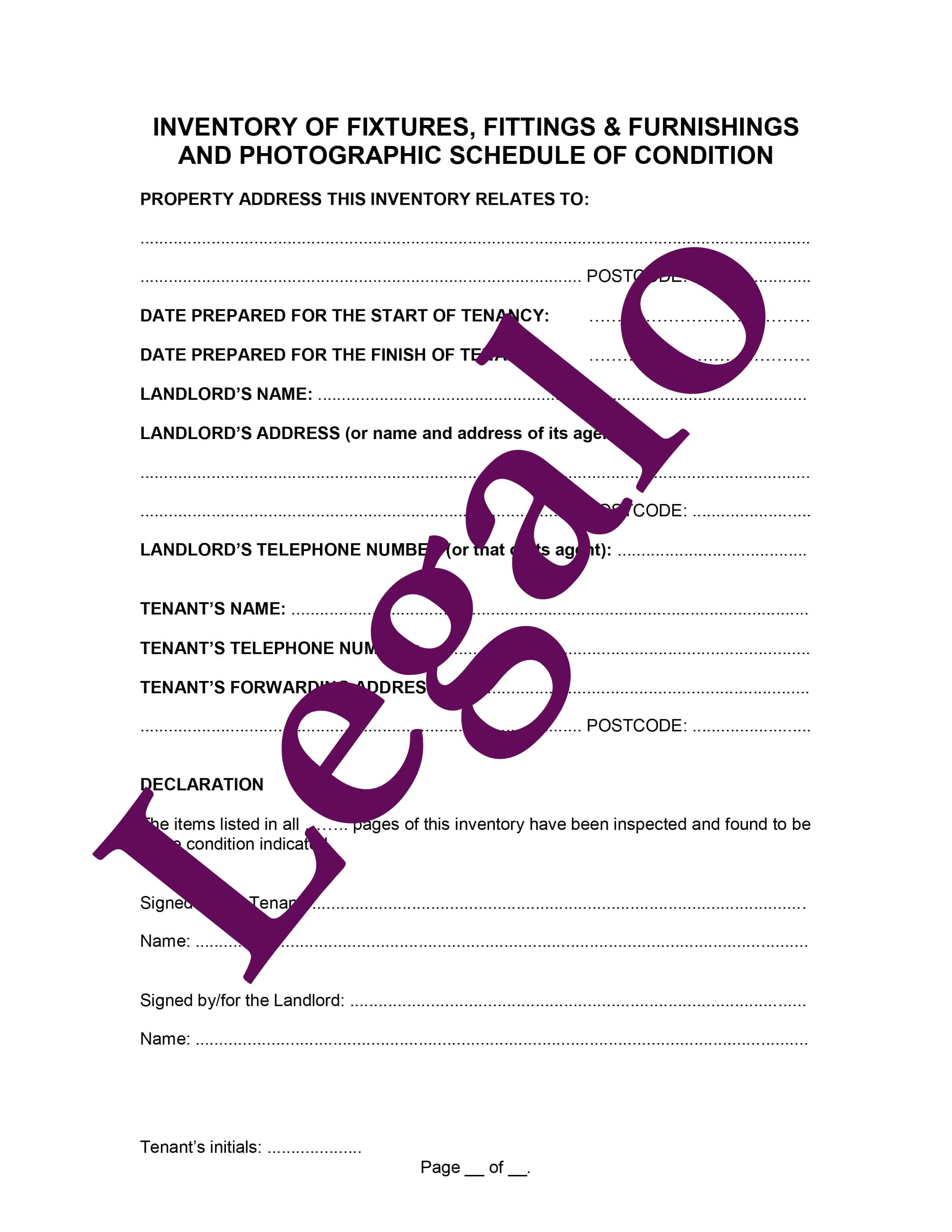Inventory
Our Inventory template:
- UK-expert-drafted template for reliability
- Easy-to-complete with guidance notes
- Includes a schedule of condition
- Full money-back guarantee

How Does It Work?
-
1. Download
-
2. Edit
-
3. Print
-
4. Sign
MD, Legalo Ltd; Solicitor; Notary Public
This is our Inventory template. It has been drafted with helping the private landlord in mind. It is for use with a residential flat or a house.
When To Use Our Template
Our inventory template is for residential tenancies, whether furnished or unfurnished. We have improved our template, to allow you to add a photographic schedule of condition. This is important so if damage or dirt is there at the end of the tenancy, as a landlord, you can charge the tenant for the repair bill or reasonable cleaning costs. This becomes even more important should you permit the tenant to have a pet at the property. If you do, use our Pet Policy template too.
We have designed it to be used when you want to let residential property. You can customise it to suit your individual requirements.
David, one of our founders and solicitor of over twenty years, has produced the template. This ensures that you can rely on the document being up-to-date and legally comprehensive. Our detailed guidance notes (free with the inventory template) make completing the final inventory simple and fast. A copy of the guidance notes are available here: guide to this inventory template.
How To Use Our Template
You can download this template for an inventory in Word format once bought. Then you can easily edit it to suit your own needs.
We provide a full money-back guarantee if you are not happy with your template document for any reason.
When you have bought it, you can reuse the template as many times as you want for creating inventories at no further cost. We keep our templates under review to ensure they are up-to-date. When we update a template that you have bought, we will notify you by email. Then you will get free access to the updated template.
For easier check-ins and check-outs
Our free guide as to how to fill out the Inventory template includes some practical tips on (a) how, why and when to use it, and (b) dealing with deposit holding schemes at the end of the tenancy in the event of the tenant having caused damage. You should take great care over the check-in process when you accept a new tenant and the corresponding check-out process when a tenant leaves, to ensure all facilities and contents work and are in good order.
This is important (a) whenever you have to make a claim on the deposit or (b) if the tenant claims something was not in good order shortly after he has moved in. You will find having an accurate inventory invaluable as part of any claim on the deposit where a deposit protection scheme holds it, as you can use the document as proof as to the situation.
FAQs on an Inventory
Below, we have answered the most popular questions from the Internet on this topic.
What should a property inventory include?
A property inventory should include a comprehensive list of all items and furnishings within a residential property, along with their condition and location. It should note any damages or wear and tear, ideally supported by photographs. The series of photographs are known as a schedule of condition. Details about fixtures, appliances, and the overall cleanliness of the property are essential. Additionally, both the tenant and landlord should sign and date the inventory to confirm agreement to its accuracy.
How to do an inventory for a property
To conduct a property inventory, begin with a room-by-room walk-through, listing all items and their condition. Use our template to note specific details, including any damage or wear, and take clear photographs of each item proving these details. Include details on fixtures, appliances, and cleanliness. Both tenant and landlord should then review and sign the inventory, so that it is clear that both parties are aware of the current condition of the property and its contents. Then be sure to recheck and update the inventory at the start and end of each tenancy for accurate records.
Can I do my own property inventory?
Yes, you can create your own property inventory, but, as with many legal documents, it is so much easier to use a good template as your starting point, rather than:
- trying to reinvent the wheel and
- risking missing something important.
Many landlords and tenants choose to hire professional inventory clerks to ensure accuracy and impartiality in the assessment. However, this can be expensive and is not essential. If you decide to do it yourself, be diligent in documenting items, their condition, and taking clear photos.
What is an example of a property inventory?
An example of a property inventory includes a detailed list of items within a residential property, such as furniture, appliances, and fixtures. You describe each item, and note its condition including photographs to provide visual evidence. The inventory should also mention the cleanliness, and the condition, of the property itself. It should be signed by both the landlord and tenant to show their agreement to it. This document serves as a reference point to avoid disputes and assess damage during the tenancy and after it ends.
What is an inventory checklist?
An inventory checklist is a structured document used systematically to:
- list the contents, and
- assess the condition, of a property.
It typically includes sections for each room or area, with spaces to detail the contents, note their condition, and attach photographs. It serves as a comprehensive reference for landlords and tenants during property inspections, rental agreements, and check-ins or check-outs. The checklist ensures that all aspects of the property are documented accurately, reducing disputes and providing a clear record of the property’s state at a specific point in time.
What are the advantages of making an inventory?
Creating a property inventory offers several advantages. It provides a clear record of a property’s condition and of its contents at the start of a tenancy, reducing disputes over damages and security deposit deductions. It ensures both landlords and tenants have a mutual understanding of the property’s contents and state. An inventory can also be crucial evidence in case of legal disputes or claims. It promotes transparency, accountability, and fairness, benefiting all parties involved in the rental process. To get the best out of it, the landlord or its agent should be meticulous in the check-out process.
Do landlords have to provide an inventory?
In the UK, landlords are not legally required to provide an inventory, but it is strongly recommended for both parties’ protection. An inventory helps prevent disputes over the property’s condition and its contents, especially when it comes to security deposits and damages at the end of a tenancy. Not providing one may pose challenges in case of disagreements between landlords and tenants. Since the advent of deposit protection schemes, landlords have to fight hard to get any compensation if a tenant damages the property or its contents. So sensible landlords choose to use an inventory to establish a clear record of the property’s state at the start of the tenancy.
What happens if a landlord does not do an inventory?
Without an inventory, it becomes more challenging to resolve disputes over the property’s condition, damages, and deductions from the security deposit. The absence of a documented record, such as photographs and detailed notes on the condition of property, will favour tenants in case of disagreements. This is because the deposit protection scheme will almost certainly reject the relevant parts of the landlord’s claim. A comprehensive inventory helps ensure fairness for both parties, making it advisable for landlords to create one to ensure a transparent and fair process during and after a tenancy.
What should an inventory look like?
A comprehensive property inventory should be:
- well-organised; and
- include detailed descriptions of all items, furnishings, and fixtures within a residential property.
It should also note the condition of each item, ideally with accompanying photographs. It would be a good idea to structure the document by room, with clear headings and categories for easy reference. Then both the landlord and tenant should review, sign, and date the inventory, confirming its accuracy.
Do tenants have to pay for an inventory?
No, as it is the landlord’s responsibility to cover the costs of the inventory if they want to use one. There are certain charges that the law in the UK does not allow landlords to pass on to a tenant.
What items are included in inventory?
An inventory for a residential property typically includes all items, furnishings, and fixtures present in the property. This encompasses furniture, appliances, décor, and other contents. Landlords often include clear photographs of items and their condition for reference.
What should not be included in an inventory?
In an inventory, items that you should not include are:
-
personal belongings of the tenant, such as clothing, toiletries, and personal electronics; and
-
any items that were previously on the inventory under the last tenant but are no longer there, perhaps because they got taken or damaged.
The tenant’s personal items are not the landlord’s responsibility to document, as they are the tenant’s private possessions and not part of the rental agreement or property inventory.





